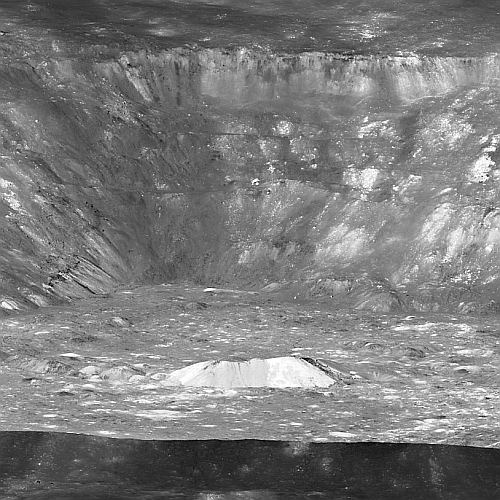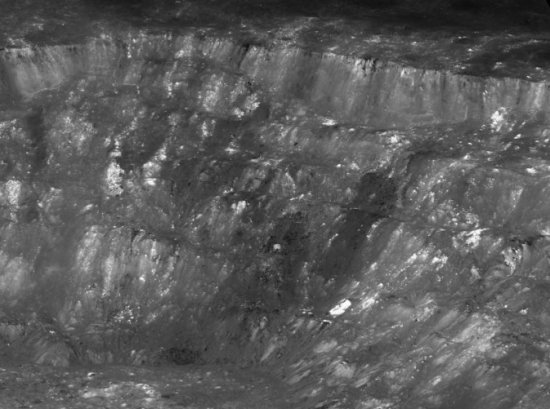The steep interior rim of Aristarchus Crater
Cool image time! The photo to the right, cropped, reduced, and sharpened to post here, is a just released image taken by Lunar Reconnaissance Orbiter, looking across the top of Aristarchus Crater on the Moon from a height of only 60 miles, with the dark surrounding plateau in the foreground contrasting sharply with the bright crater interior. For scale, the distance from the floor of the crater to the top of the rim is about 9,000 feet. The bright central peak is about 1,300 feet tall. The contrast in brightness inside and outside the crater is explained thus:
Adjacent to Aristarchus crater is the Aristarchus plateau, one of the largest volcanic centers on the Moon. Here we find one of the largest rilles [on the Moon, dubbed Vallis Schröteri], a massive pyroclastic deposit, and the source of extensive flood basalts.
These volcanic materials are considered relatively young (for the Moon) – 1.5 to 2.5 billion years. The pyroclastic deposit formed when magma was explosively ejected from the vent and broke into small droplets quenched as glass in the cold vacuum of space as they fell back to the surface. Due to their high glass content, the pyroclastic deposits are distinctly low in albedo (relatively dark), providing a dark background for the bright Aristarchus crater. Within the crater, some of these pyroclastic deposits may be visible as the darkest areas on the far wall, and glassy impact melt is moderately lower in reflectance than the bright, rocky materials exposed on areas of the crater floor and walls.
The overview map below shows both the crater and the vent from which Vallis Schröteri belched.
» Read more
Cool image time! The photo to the right, cropped, reduced, and sharpened to post here, is a just released image taken by Lunar Reconnaissance Orbiter, looking across the top of Aristarchus Crater on the Moon from a height of only 60 miles, with the dark surrounding plateau in the foreground contrasting sharply with the bright crater interior. For scale, the distance from the floor of the crater to the top of the rim is about 9,000 feet. The bright central peak is about 1,300 feet tall. The contrast in brightness inside and outside the crater is explained thus:
Adjacent to Aristarchus crater is the Aristarchus plateau, one of the largest volcanic centers on the Moon. Here we find one of the largest rilles [on the Moon, dubbed Vallis Schröteri], a massive pyroclastic deposit, and the source of extensive flood basalts.
These volcanic materials are considered relatively young (for the Moon) – 1.5 to 2.5 billion years. The pyroclastic deposit formed when magma was explosively ejected from the vent and broke into small droplets quenched as glass in the cold vacuum of space as they fell back to the surface. Due to their high glass content, the pyroclastic deposits are distinctly low in albedo (relatively dark), providing a dark background for the bright Aristarchus crater. Within the crater, some of these pyroclastic deposits may be visible as the darkest areas on the far wall, and glassy impact melt is moderately lower in reflectance than the bright, rocky materials exposed on areas of the crater floor and walls.
The overview map below shows both the crater and the vent from which Vallis Schröteri belched.
» Read more


